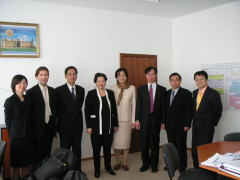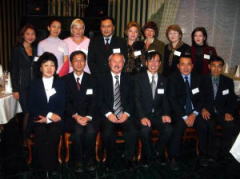Dispatch of Medical Professionals
Home > Dispatch of Medical Professionals > Dispatch List > HICARE Mission to Kazakhstan
HICARE Mission to Kazakhstan
HICARE dispatched a delegation, consisting of Dr. Arita, a member of the Board of Executive Secretaries, and two secretariats, to Kazakhstan for the following purposes:
To verify the practical effectiveness of:
HICARE training in Hiroshima for medical experts invited from Kazakhstan,
The experiences of experts dispatched from Hiroshima to Kazakhstan.
Additional goals were:
To re-establish the network between trainees and HICARE
To review how HICARE is going to support health care for radiation-exposed patients in Kazakhstan.
Period:
Members:
| Dr. Kenichi Arita | Member of the Board of Executive Secretaries of HICARE |
| Two Secretariats |
Institutes/Hospitals visited:
Astana
Embassy of Japan in Kazakhstan
Ministry of Health (Kazakhstan)
Kazakhstan National Medical Academy
Ust-Kamenogorsk
Health Care Department of the East-Kazakhstan State Government
Ust-Kamenogorsk Oncology Center
Semipalatinsk
Semipalatinsk City Government
Semipalatinsk Consultative Diagnosis Center
Kazakhstan National Research Institute for Radiation Medicine and Ecology
Semipalatinsk Oncology Center
Semipalatinsk Medical Academy Hospital
Nuclear tests land in Semipalatinsk region
Impressions:
Introduction
The Republic of Kazakhstan is a country with significant resources, being located midway along the Silk Road route. A great number of people were exposed to radiation during periods of nuclear experimentation conducted by the Soviet Union during their governance; the people are presently suffering from the aftereffects. Consequently, since 1992, HICARE has invited a total of 27 medical experts from the Semipalatinsk region for training in Hiroshima. Similarly, HICARE has dispatched 23 experts from Hiroshima to engage in medical support activities in the same region.
In order to verify the practical effectiveness of our support in Kazakhstan, we took an approximately one-week visit (from September 26, 2005) to various cities in Kazakhstan, confirming the progress of our former trainees. Cities included were Astana, Ust-kamenogorsk, and Semipalatinsk.

With Dr. Dikanvayeva, Vice Minister (the fourth from right) and the HICARE concerned people (At the Ministry of Health)
Astana and Ust-Kamenogorsk
In Astana, the capital of Kazakhstan, we visited the Embassy of Japan, the Ministry of Health, and the Kazakhstan National Medical Academy. Courtesy calls were made to Mr. Kadosaki, Ambassador to Kazakhstan, and we were privileged the opportunity to explain HICARE's medical support activities for radiation-exposed patients. At the Ministry of Health, we visited with Dr. Dikanvayeva, the Vice Minister. Dr. Dikanvayeva informed us that the experts who undergo HICARE's training take up a major role in treatment activities for radiation victims in Kazakhstan. The Government would like to focus on database construction as well as the formulation of guidelines for a monetary compensation program. They noted the need for Japanese cooperation to realize these projects. Subsequently, we met with a number of medical doctors via the kind offices of Dr. Rozenson, Professor at the Kazakhstan Medical Academy.
Semipalatinsk
On September 29, 2005, we arrived in Semipalatinsk City. It was Dr. Sagadat who supported our activities there. She kindly made the arrangements for us to visit institutes/hospitals. She looked remarkably similar to the Japanese, working as a doctor of internal medicine at Semipalatinsk Diagnosis Center. At this diagnosis center, there was a "Takagi Memorial Exhibition Room" commemorating the now-deceased Dr. Masahiko Takagi. Upon entering the room, one was greeted by the Japanese song "Furusato." Exhibited there were objects Dr. Takagi used regularly, as well as a collection of his photographs. Over one of his portraits, there was a sign written in Japanese: "Kokoro no fureai," or "Heart to heart exchange". After retirement from his work, he lived in the area with his wife, a radiation victim from the Hiroshima Atomic Bomb, supporting radiation-exposed patients. He died in Semipalatinsk in 2002. He started to learn Kazakhstan’s language at over 70 years of age. He is greatly loved by the people of Kazakhstan. His effect on the people of Kazakhstan was profound, and as such the “memorial room" was created. Writing my name and impressions within the signature book, I could not help but shed tears; his sense of purpose towards this country, as well as the purity and generosity of both Dr. Takagi and the people of Kazakhstan were very moving.
In the afternoon of the same day, we made a courtesy call to Mr. Omarov, Mayor of Semipalatinsk. Our meeting covered a wide range of topics, such as Lady Omarova's medical training via HICARE, exchanges with the Mayor of Hiroshima, and HICARE's future activities after the completion of the JICA project. Media attention seemed significant.
In addition, at a meeting with leading radiation treatment experts from Semipalatinsk Medical Academy, Semipalatinsk Medical Academy Hospital, Semipalatinsk Oncology Center, The National Research Institute for Radiation Medicine and Ecology, and others, we listened intently to the desires and expectations of our program. It was exceedingly beneficial.

With HICARE trainees and the HICARE concerned people (In Semipalatinsk City)
Exchange with HICARE's trainees in Semipalatinsk
In order to re-establish a network with HICARE's trainees, we held an exchange meeting in Semipalatinsk on September 30. We had friendly talks with a total of 14 participants, including Dr. Esen, Deputy Director of Semipalatinsk Medical Academy Hospital, and Dr. Tasbolat, Deputy of Head Doctor of Semipalatinsk Oncology Center. Seven former trainees were present. While the trainees sang Japanese songs they learned during their stay in Hiroshima, participants stood with their arms around each other. The meeting resulted in some rather heartwarming exchanges.
Hiroshima Semipalatinsk Project
During our stay in Kazakhstan, we were assisted by interpreters who studied at Sanyo Girls' Senior High School. At present, the school has received 11 overseas students from Kazakhstan, cooperating with the "Hiroshima Semipalatinsk Project", a citizen’s group in Hiroshima.
Upon our visit to the Embassy of Japan in Kazakhstan, Mr. Kadosaki, the Ambassador, told us that there was an official working at the embassy that studied at the Sanyo school. Ms. Assel, who aided us as an interpreter in Semipalatinsk, also studied as a student of at the High School.
We realized that support activities conducted by citizen’s groups in Hiroshima have firm roots in Kazakhstan’s society.
Closing
During our stay in Kazakhstan, we felt strong expectations and longings directed at Japan. We realized our mission: that HICARE carry out medical support activities that meet the needs of the people of Kazakhstan. That we continue exchange in various medical fields as not singular events, but as a stable and continuous support; continuous support not just as guests, but as friends and colleagues working together.
Kazakhstan is now developing rapidly via the benefits of oil drilling. We would like the people of Kazakhstan not to follow our path, spiritual culture and humanity taking a back seat to material culture. We would like them to place a higher priority on their pure and generous nature. Our eight days of exchange with them reminded us of what we ourselves are sometimes lacking.
(Written by Kenichi Arita, M.D., Ph.D.)



